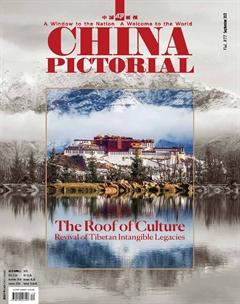Opera Troupe in a Border Village
by Li Yuan
Along the border between China, Nepal, and India is an ancient village called Korqag, located in Burang County, Ngari Prefecture, in southwestern Chinas Tibet Autonomous Region. In Tibetan language, “Korqag” means“settling down.” According to historical records, Rinchen Zangpo (958-1055), a senior monk and translator of Sanskrit Buddhist texts, established the Korqag Monastery in 996. The village was built around the ancient monastery and named after it. In January 2019, Korqag was included in the seventh group of national historical and cultural villages.
Korqag has a long history of foreign trade and business exchange and fostered a unique local culture, thanks to its special location. For example, some inhabiting the village wear a kind of stunning garment with exotic style inspired by a peacock tail. From design and making of the garments to choosing accessories, this kind of costumes seeks to capture the beauty of a peacock.
Even Tibetan Opera, one of the most profound Tibetan cultural legacies, developed a unique style in the ancient border village.
According to Dawa Lodro, head of the Korqag Tibetan Opera Troupe, Korqags opera starkly contrasts productions from Lhasa in singing, dancing, and music.
“The drums that we use have long handles like those in the temples. The style of playing is also different from other places and shares some similarities with the Indian style.” Dawa Lodro believes that such unique features distinguish the troupe from the other 163 Tibetan Opera troupes in the autonomous region and give it great market potential.
The troupes singularity has helped it be invited to perform at the Shoton Festival in Lhasa eight times since 2001. The Shoton Festival, or Yogurt Festival, is a traditional festival for Tibetans. After thousands of years of development, it has evolved into a comprehensive event integrating art performance, tourism, entertainment, trade talks, and academic exchange.
The 40-year old Dawa Lodro is both the manager and an actor of the troupe. He often plays hunters in performances due to his robust physique. At the age of 18, he made his debut on the stage. He learned the acting skills by watching his father and grandfather. Studying elder generations and other performers is a key method to study Tibetan Opera.
Today, Prince Losang is one of the most popular plays of the Korqag Tibetan Opera Troupe. The production is also the most time-consuming, the most difficult, and the most exhausting, according to Dawa Lodro.“However, the story is tightly linked to our hometown Burang, which is the main reason we like it,” he said. “We want to perform it in more places and help more people know our story.”
Set 3,000 years ago, the play follows Prince Losang and his beloved princess. Legend holds that Prince Losang built a grand palace by the beautiful Peacock River in Burang.
Among the princes three hundred wives was a beautiful and kind princess named Yungdro Lhamo. She became so tired of jealousy and persecution from other consorts that one full moon night, she transformed into a peafowl, flew over the snowy mountains, and disappeared into the night sky.
This fairytale inspired the play Prince Losang. The setting for the story is right around Lake Manasarovar in Burang, one of three holy lakes of Tibet. The remains of the ancient monastery and palace mentioned in the story can also be found in todays Burang County.
The unabridged play runs for a total of eight hours. The only chances spectators can see the entire show are special occasions like the Shoton Festival. In other cases, only a few selected scenes are performed.
In the days before other entertainment choices were available, Tibetan Opera in the little border village was part of life rather than a stage art.
“In the 1980s, most performances received nothing but salt for compensation, but actors still maintained enthusiasm,” revealed Dawa Lodro. “The plays were staged during festivals, slack farming season, and other celebrations, and almost half of the village participated.”
Today, about 600 people live in Korqag, while the local Tibetan Opera troupe has only 18 performers, including two old men and 16 middle-aged members.
Dawa Lodro recognizes the problem of few inheritors, but hasnt found a solution yet. “We cant blame young people for their choices,” he said. “They have their own reasons. With so many diverse entertainment choices available today, perhaps only older generations can still appreciate the beauty of Tibetan Opera. And income from Tibetan Opera performances is not enough to feed a family. They may want to contribute to the development of Tibetan Opera, but they need some security in terms of paying the bills.”
Luckily, as a living fossil of Tibetan culture, the inheritance and protection of Tibetan Opera has received great support from governments at all levels. At present, the Korqag Tibetan Opera Troupe receives an annual 250,000 yuan (US$38,600) subsidy from the central government and another 20,000 yuan (US$3,088) from the local government. The county government bought them new costumes. Dawa Lodro has been mulling creation of new plays to keep pace with the times.
At 80, Karkhyungpa is the oldest member of the troupe. He shifted from an actor to a drum player 15 years ago but continues to mentor young performers. He plans on staying with the troupe as long as he can contribute.

